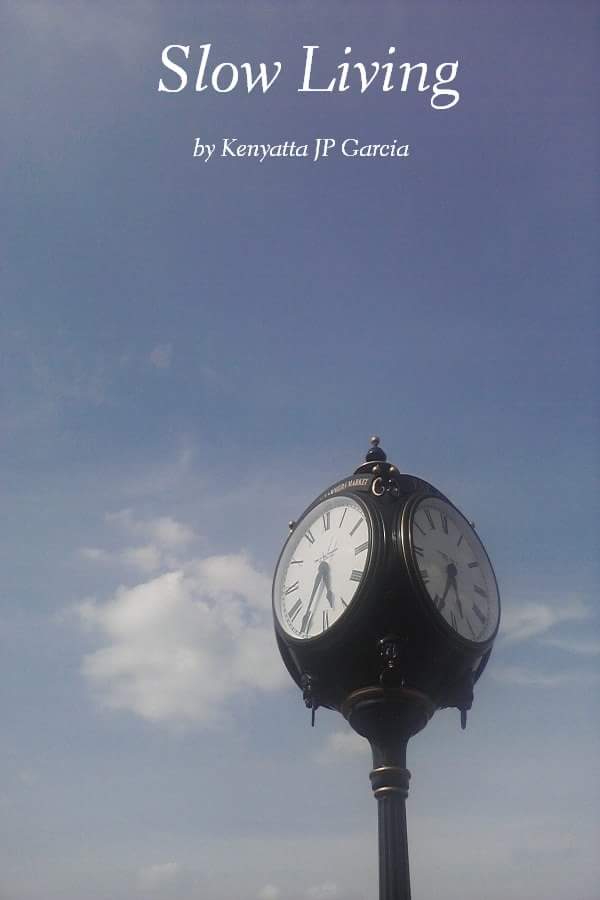ISSN: 1941-4137
POETRY THAT ENACTS THE ARTISTIC AND CREATIVE PURITY OF GLASS
POETRY THAT ENACTS THE ARTISTIC AND CREATIVE PURITY OF GLASS

Laurin DeChae is a PhD candidate in Composition & Rhetoric at SUNY Albany, acting as the poetry editor for Barzakh Magazine. She received her MFA in poetry from the University of New Orleans. Her work appears or is forthcoming in Harpur Palate, Animal Literary, Pretty Owl Poetry and elsewhere.
April 28, 2017
Edited by Stephanie Kaylor
Edited by Stephanie Kaylor
Review of Slow Living by Kenyatta JP Garcia, with Interview
 Slow Living
by Kenyatta JP Garcia
West Vine Press, 2016
Kenyatta JP Garcia's fourth collection of poetry, Slow Living from West Vine Press, is an enfolding of space, time, and geography as the author narrates the world they inhabit through devices like allusion, myth, sonics, and the fragment. Broken into two sections, "(Slow Living (Racing Thoughts))" and "(Dear/Later)," this text begs questions of the self both embodied and disembodied as a means of probing the world the self inhabits by way of holding a stethoscope up to the echoes of the past, while also gleaning premonitions of the future. In the former section, and the shorter of the two, a sort of mytho- and metapoetics become the vehicle for existential thought, posing questions like this one, which opens the text: "Where are those slippers,/glasses,/and coffee just set down?" On the surface this may seem a banal question, however, from the beginning Garcia sets the pace, which they fully intend to shift later. When the author provides answers to these questions, the reader is forced to slow down and reflect knowing that the clock is ticking in the background and the reader is racing against the author's own line of thinking.
Surely it's the heart before the course
revolutionary suicide,
sun sets and rises
and no reason
to see the clock's hands before noon.
When Garcia asks, "This is the body to sing?" it is more a challenge than a question, for, as they write, this is a "song sung by heart." If one fails to challenge or mediate the pace set by normative standards, then, it would seem, one is all the more likely to get swept up in it. The first section ends with the same cup of coffee that started this meditation; quickly collapsing the time it took for the reader to traverse those pages.
In the latter section, the author takes on the diary form as a means of interjecting the self with the self: past, present, and future. One might view these two sections as retrospection and introspection respectively. The text also approaches cliché as a form, reflecting on the necessary revisions of living while challenging the idea of universal truth. As one progresses through these poems typographical fragmentation, backslashes, parentheticals and brackets, deconstructs even the smallest parts of speech, which continues to distort and challenge these "truths" as Garcia writes "A thousand miles away from something too and even from the selfsame self."
Slow Living raises questions about the body, home, and historical memory, as well as singular and collective identities that may circularly define one another. What we see is the author on a quest for answers and while doing so they encounter or invoke characters from Arthurian myth, comic book heroes and heroines, as well as notable philosophers, to name a few. The author's use of the second person places the reader directly within the narrative and persistently points to "you" aligning author and reader in this reflective space.
Ultimately Slow Living is a commentary on art and its relationship to the artist. It is a text that works in assemblage by means of creating a multivocal narrative, whether that means calling on Lichtenstein or Sophocles, or the iterations of the multiplicitous author. Upon first glance this may seem like an exercise in circularity, but, no, this text takes on a different shape — that of the spiral. To go down this spiral means acknowledging, as Garcia writes, "It's already later. So remember, life isn't always beautiful but at least you are."
Interview with Kenyatta JP Garcia, author of Slow Living:
Laurin DeChae: Tell me about halves, real and imagined, about the geometries that influence your work and life.
Kenyatta JP Garcia: When it comes to halves, as somebody now approaching mid-life at forty, it's kind of sad to think that you might have more behind you than ahead of you. For me, to talk about halves is talking not only about age in particular, understanding that you're not going to be what you ever were, but in moving forward you're a blend of what was already there. The other part of halves deals with, of course, a fluidity of gender and a fluidity of race. As an agender, queer person having gone through many phases of more femme or more masculine, I've definitely tried to bring that idea into my writing as much as possible. My writing is still a bit vague, though, because I don't believe that there's any reason to tell a whole story. So, part of the geometry of my storytelling is halves — telling half-truths and half-lies all the time.
LD: How can readers who are not Proust scholars access your work?
KG: Speaking of halves, I only got halfway through all of Proust. I'm in the middle of the fourth book. A lot of my stuff is based really on the first two, especially the second. I don't really like Guermante's Way, which is sad because Jean Genet loved that book and I thought I would love it, too, because I love Jean Genet. So, you don't need to be a Proust scholar, but it helps to know a little about Proust, I think. Any kind of writing I do is writing into something or writing back to something else. I hope that someone has read the same things I have so they understand the allusions. For me, I feel like if you don't know Proust, that's fine. We all understand what it's like to live in a memory, we all understand what it's like to have things that you've never had — unrequited loves, failures, all sorts of things like that. Proust's very much into that. I didn't quite get anything that I wanted often. So, there's a lot of that in there. There other thing with allusion, for me, is that Proust is always looking at stuff and I want to get people to look at stuff even if it's just with mental eyes. As opposed to J. H. Prynne's mental ears, I want mental eyes. I want readers to visualize something when they're reading my work, but I don't want to give them the whole image. Again, halves. I think that's something that Proust doesn't do. Proust gives you a very acute look at things and that was my moment of departure from him, which is very hard to do. I have this idea that Lorca put in me: imagination, inspiration, and evasion. I was inspired by Proust, I had my imagination to write, but I had to evade — I couldn't do exactly what he was doing.
LD: This work seems to be concerned with both embodiment and disembodiment, can you speak to this?
KG: When I write anything I want it to feel very loose. I don't want you to be me. Again, this is the halfway thing, the vagaries with my work. I don't want anybody to be me. I want a lot of disembodiment in it. I try to escape to give people room to do their own thing, to get into whatever they want. But at that same time, you can't fully escape because I'm not astral projecting and a little bit of me is going to be there, but this is the question, "How much do you know yourself?" I tend to think not very well. So, part of my disembodiment is the fact that I don't understand what I'm doing. I don't know where I'm going, I don't know where I've been. I feel like my memory constantly betrays me. I feel like my desires are unfluid. That's part of the disembodiment of writing anything down. I need to write something, I need to fill my time so I write things, but to what extent, I don't know. It's kind of hard to write when you don't know what you're writing about until you get that one moment of clarity.
LD: How do you see allusion functioning? Is this a move toward assemblage or simply ingrained from your own reading?
KG: Everything I read does fold into what I'm working on. In the second half of Slow Living, "(Dear/Later)," I was very much trying to write into the moment as much as possible. When I couldn't write anymore I would go back to reading and then I would get sparked by the thing I was reading, so I folded it in. I would say, "This is a line that just inspired me to write the next line, so here's the line." I want you to understand where I am right now. But I don't believe in creation at all. I'm very anti-creation. For me, everything is assembly. Everything is putting together something else. I don't believe in original thought. I don't believe in original ideas. I'm sure I've had a couple in my life, but only a couple. So I'm always trying to pile up things. Reading me is reading a compilation or reading an anthology. Allusions are the best way of doing that. Basically, you're taking an inventory of everything around you.
LD: While serious, this work also seems very playful. How does this balance figure into your writing?
KG: I didn't try to be playful in writing, I really did try to be very sincere and very honest and that, to me, is very serious work. When I write poems I'm very serious all the time. There's a point, in writing diaries, where it can't all be dour and serious. I tried to add a couple of inside jokes, but I may have made jokes so inside that they are insular to me and people may be laughing at different parts than what I want them to laugh at. It gets to a point where you're talking to yourself, which a diary is talking to yourself (and I use the second person to indicate this), that's ridiculous. It has to be playful. I also feel that poetry is a very unnatural way of putting any idea out there and in many ways a poem is a joke. At the same time, I write a lot of jokes and I think my jokes are poems, too. I may not be the best person to talk to.
Visit Kenyatta JP Garcia's Website
Visit West Vine Press' Website
Slow Living
by Kenyatta JP Garcia
West Vine Press, 2016
Kenyatta JP Garcia's fourth collection of poetry, Slow Living from West Vine Press, is an enfolding of space, time, and geography as the author narrates the world they inhabit through devices like allusion, myth, sonics, and the fragment. Broken into two sections, "(Slow Living (Racing Thoughts))" and "(Dear/Later)," this text begs questions of the self both embodied and disembodied as a means of probing the world the self inhabits by way of holding a stethoscope up to the echoes of the past, while also gleaning premonitions of the future. In the former section, and the shorter of the two, a sort of mytho- and metapoetics become the vehicle for existential thought, posing questions like this one, which opens the text: "Where are those slippers,/glasses,/and coffee just set down?" On the surface this may seem a banal question, however, from the beginning Garcia sets the pace, which they fully intend to shift later. When the author provides answers to these questions, the reader is forced to slow down and reflect knowing that the clock is ticking in the background and the reader is racing against the author's own line of thinking.
Surely it's the heart before the course
revolutionary suicide,
sun sets and rises
and no reason
to see the clock's hands before noon.
When Garcia asks, "This is the body to sing?" it is more a challenge than a question, for, as they write, this is a "song sung by heart." If one fails to challenge or mediate the pace set by normative standards, then, it would seem, one is all the more likely to get swept up in it. The first section ends with the same cup of coffee that started this meditation; quickly collapsing the time it took for the reader to traverse those pages.
In the latter section, the author takes on the diary form as a means of interjecting the self with the self: past, present, and future. One might view these two sections as retrospection and introspection respectively. The text also approaches cliché as a form, reflecting on the necessary revisions of living while challenging the idea of universal truth. As one progresses through these poems typographical fragmentation, backslashes, parentheticals and brackets, deconstructs even the smallest parts of speech, which continues to distort and challenge these "truths" as Garcia writes "A thousand miles away from something too and even from the selfsame self."
Slow Living raises questions about the body, home, and historical memory, as well as singular and collective identities that may circularly define one another. What we see is the author on a quest for answers and while doing so they encounter or invoke characters from Arthurian myth, comic book heroes and heroines, as well as notable philosophers, to name a few. The author's use of the second person places the reader directly within the narrative and persistently points to "you" aligning author and reader in this reflective space.
Ultimately Slow Living is a commentary on art and its relationship to the artist. It is a text that works in assemblage by means of creating a multivocal narrative, whether that means calling on Lichtenstein or Sophocles, or the iterations of the multiplicitous author. Upon first glance this may seem like an exercise in circularity, but, no, this text takes on a different shape — that of the spiral. To go down this spiral means acknowledging, as Garcia writes, "It's already later. So remember, life isn't always beautiful but at least you are."
Interview with Kenyatta JP Garcia, author of Slow Living:
Laurin DeChae: Tell me about halves, real and imagined, about the geometries that influence your work and life.
Kenyatta JP Garcia: When it comes to halves, as somebody now approaching mid-life at forty, it's kind of sad to think that you might have more behind you than ahead of you. For me, to talk about halves is talking not only about age in particular, understanding that you're not going to be what you ever were, but in moving forward you're a blend of what was already there. The other part of halves deals with, of course, a fluidity of gender and a fluidity of race. As an agender, queer person having gone through many phases of more femme or more masculine, I've definitely tried to bring that idea into my writing as much as possible. My writing is still a bit vague, though, because I don't believe that there's any reason to tell a whole story. So, part of the geometry of my storytelling is halves — telling half-truths and half-lies all the time.
LD: How can readers who are not Proust scholars access your work?
KG: Speaking of halves, I only got halfway through all of Proust. I'm in the middle of the fourth book. A lot of my stuff is based really on the first two, especially the second. I don't really like Guermante's Way, which is sad because Jean Genet loved that book and I thought I would love it, too, because I love Jean Genet. So, you don't need to be a Proust scholar, but it helps to know a little about Proust, I think. Any kind of writing I do is writing into something or writing back to something else. I hope that someone has read the same things I have so they understand the allusions. For me, I feel like if you don't know Proust, that's fine. We all understand what it's like to live in a memory, we all understand what it's like to have things that you've never had — unrequited loves, failures, all sorts of things like that. Proust's very much into that. I didn't quite get anything that I wanted often. So, there's a lot of that in there. There other thing with allusion, for me, is that Proust is always looking at stuff and I want to get people to look at stuff even if it's just with mental eyes. As opposed to J. H. Prynne's mental ears, I want mental eyes. I want readers to visualize something when they're reading my work, but I don't want to give them the whole image. Again, halves. I think that's something that Proust doesn't do. Proust gives you a very acute look at things and that was my moment of departure from him, which is very hard to do. I have this idea that Lorca put in me: imagination, inspiration, and evasion. I was inspired by Proust, I had my imagination to write, but I had to evade — I couldn't do exactly what he was doing.
LD: This work seems to be concerned with both embodiment and disembodiment, can you speak to this?
KG: When I write anything I want it to feel very loose. I don't want you to be me. Again, this is the halfway thing, the vagaries with my work. I don't want anybody to be me. I want a lot of disembodiment in it. I try to escape to give people room to do their own thing, to get into whatever they want. But at that same time, you can't fully escape because I'm not astral projecting and a little bit of me is going to be there, but this is the question, "How much do you know yourself?" I tend to think not very well. So, part of my disembodiment is the fact that I don't understand what I'm doing. I don't know where I'm going, I don't know where I've been. I feel like my memory constantly betrays me. I feel like my desires are unfluid. That's part of the disembodiment of writing anything down. I need to write something, I need to fill my time so I write things, but to what extent, I don't know. It's kind of hard to write when you don't know what you're writing about until you get that one moment of clarity.
LD: How do you see allusion functioning? Is this a move toward assemblage or simply ingrained from your own reading?
KG: Everything I read does fold into what I'm working on. In the second half of Slow Living, "(Dear/Later)," I was very much trying to write into the moment as much as possible. When I couldn't write anymore I would go back to reading and then I would get sparked by the thing I was reading, so I folded it in. I would say, "This is a line that just inspired me to write the next line, so here's the line." I want you to understand where I am right now. But I don't believe in creation at all. I'm very anti-creation. For me, everything is assembly. Everything is putting together something else. I don't believe in original thought. I don't believe in original ideas. I'm sure I've had a couple in my life, but only a couple. So I'm always trying to pile up things. Reading me is reading a compilation or reading an anthology. Allusions are the best way of doing that. Basically, you're taking an inventory of everything around you.
LD: While serious, this work also seems very playful. How does this balance figure into your writing?
KG: I didn't try to be playful in writing, I really did try to be very sincere and very honest and that, to me, is very serious work. When I write poems I'm very serious all the time. There's a point, in writing diaries, where it can't all be dour and serious. I tried to add a couple of inside jokes, but I may have made jokes so inside that they are insular to me and people may be laughing at different parts than what I want them to laugh at. It gets to a point where you're talking to yourself, which a diary is talking to yourself (and I use the second person to indicate this), that's ridiculous. It has to be playful. I also feel that poetry is a very unnatural way of putting any idea out there and in many ways a poem is a joke. At the same time, I write a lot of jokes and I think my jokes are poems, too. I may not be the best person to talk to.
Visit Kenyatta JP Garcia's Website
Visit West Vine Press' Website
Glass: A Journal of Poetry is published monthly by Glass Poetry Press.
All contents © the author.
All contents © the author.





